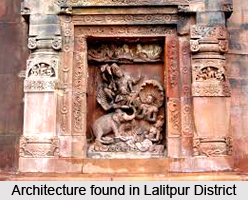 History of Lalitpur District says that it was formerly a part of the state of Chanderi, founded in 17th century by Bundela Rajputs who descended from Rudra Pratap of Orchha. Chanderi, along with most of Bundelkhand, came under Maratha dominion in the 18th century. Daulat Rao Sindhia of neighbouring Gwalior state annexed Chanderi state in 1811. In 1844, the former state of Chanderi was surrendered to the British, and it became the Chanderi District of British India, with Lalitpur town as the district headquarters. Further, the history of Lalitpur District states that the British lost the district in the Indian Rebellion of 1857, and it was not re-conquered until late 1858. In 1861, some portion of the district, including Chanderi, was returned to Gwalior, and the rest was renamed as Lalitpur District. Lalitpur District was made part of Jhansi District from 1891 to 1974.
History of Lalitpur District says that it was formerly a part of the state of Chanderi, founded in 17th century by Bundela Rajputs who descended from Rudra Pratap of Orchha. Chanderi, along with most of Bundelkhand, came under Maratha dominion in the 18th century. Daulat Rao Sindhia of neighbouring Gwalior state annexed Chanderi state in 1811. In 1844, the former state of Chanderi was surrendered to the British, and it became the Chanderi District of British India, with Lalitpur town as the district headquarters. Further, the history of Lalitpur District states that the British lost the district in the Indian Rebellion of 1857, and it was not re-conquered until late 1858. In 1861, some portion of the district, including Chanderi, was returned to Gwalior, and the rest was renamed as Lalitpur District. Lalitpur District was made part of Jhansi District from 1891 to 1974.
Further, as per the historical accounts, Lalitpur was carved out as a district in the year 1974. Lalitpur is joined to Jhansi District of Uttar Pradesh by a narrow corridor to the northeast, but is otherwise almost completely surrounded by Madhya Pradesh; to the east there is Tikamgarh District, to the south Sagar District, and to the west Ashoknagar District and Shivpuri District. Lalitpur, Jalaun and Jhansi districts form Jhansi Division. Jhansi Division is one of 17 divisions of Uttar Pradesh in northern India. It includes Jhansi, Jalaun, and Lalitpur districts. The city of Jhansi is the administrative centre. The division is part of the historic Bundelkhand region, which includes a portion of southern Uttar Pradesh and extends into the neighbouring state of Madhya Pradesh.
This article is a stub. You can enrich by adding more information to it. Send your Write Up to content@indianetzone.com



















